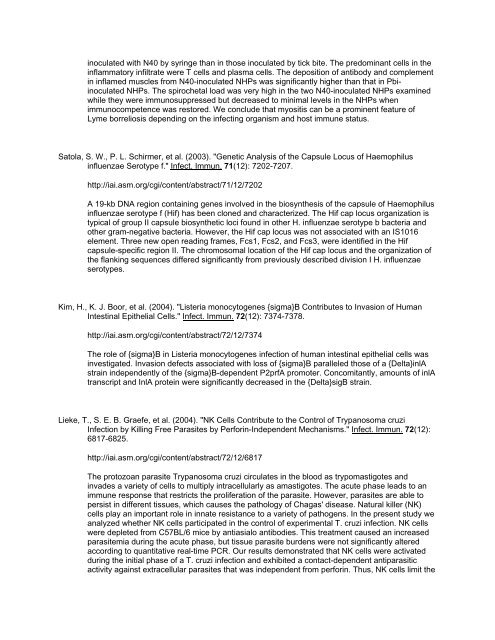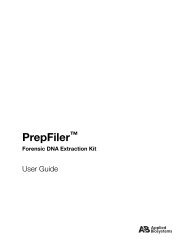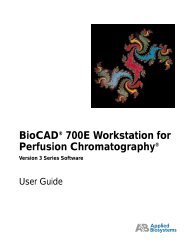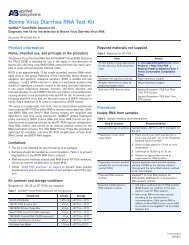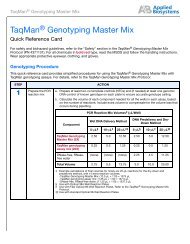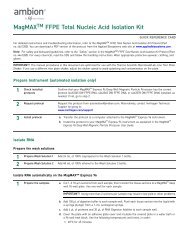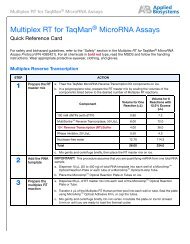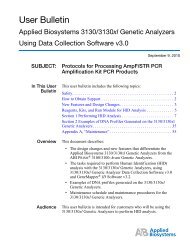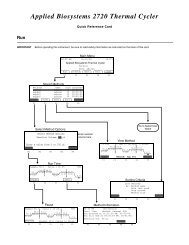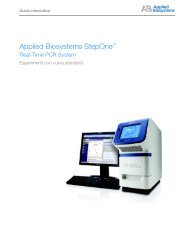inoculated with N40 by syringe than in those inoculated by tick bite. The predominant cells in theinflammatory infiltrate were T cells <strong>and</strong> plasma cells. The deposition of antibody <strong>and</strong> complementin inflamed muscles from N40-inoculated NHPs was significantly higher than that in PbiinoculatedNHPs. The spirochetal load was very high in the two N40-inoculated NHPs examinedwhile they were immunosuppressed but decreased to minimal levels in the NHPs whenimmunocompetence was restored. We conclude that myositis can be a prominent feature ofLyme borreliosis depending on the infecting organism <strong>and</strong> host immune status.Satola, S. W., P. L. Schirmer, et al. (2003). "Genetic Analysis of the Capsule Locus of Haemophilusinfluenzae Serotype f." Infect. Immun. 71(12): 7202-7207.http://iai.asm.org/cgi/content/abstract/71/12/7202A 19-kb <strong>DNA</strong> region containing genes involved in the biosynthesis of the capsule of Haemophilusinfluenzae serotype f (Hif) has been cloned <strong>and</strong> characterized. The Hif cap locus organization istypical of group II capsule biosynthetic loci found in other H. influenzae serotype b bacteria <strong>and</strong>other gram-negative bacteria. However, the Hif cap locus was not associated with an IS1016element. Three new open reading frames, Fcs1, Fcs2, <strong>and</strong> Fcs3, were identified in the Hifcapsule-specific region II. The chromosomal location of the Hif cap locus <strong>and</strong> the organization ofthe flanking sequences differed significantly from previously described division I H. influenzaeserotypes.Kim, H., K. J. Boor, et al. (2004). "Listeria monocytogenes {sigma}B Contributes to Invasion of HumanIntestinal Epithelial Cells." Infect. Immun. 72(12): 7374-7378.http://iai.asm.org/cgi/content/abstract/72/12/7374The role of {sigma}B in Listeria monocytogenes infection of human intestinal epithelial cells wasinvestigated. Invasion defects associated with loss of {sigma}B paralleled those of a {Delta}inlAstrain independently of the {sigma}B-dependent P2prfA promoter. Concomitantly, amounts of inlAtranscript <strong>and</strong> InlA protein were significantly decreased in the {Delta}sigB strain.Lieke, T., S. E. B. Graefe, et al. (2004). "NK Cells Contribute to the Control of Trypanosoma cruziInfection by Killing Free Parasites by Perforin-Independent Mechanisms." Infect. Immun. 72(12):6817-6825.http://iai.asm.org/cgi/content/abstract/72/12/6817The protozoan parasite Trypanosoma cruzi circulates in the blood as trypomastigotes <strong>and</strong>invades a variety of cells to multiply intracellularly as amastigotes. The acute phase leads to animmune response that restricts the proliferation of the parasite. However, parasites are able topersist in different tissues, which causes the pathology of Chagas' disease. Natural killer (NK)cells play an important role in innate resistance to a variety of pathogens. In the present study weanalyzed whether NK cells participated in the control of experimental T. cruzi infection. NK cellswere depleted from C57BL/6 mice by antiasialo antibodies. This treatment caused an increasedparasitemia during the acute phase, but tissue parasite burdens were not significantly alteredaccording to quantitative real-time PCR. Our results demonstrated that NK cells were activatedduring the initial phase of a T. cruzi infection <strong>and</strong> exhibited a contact-dependent antiparasiticactivity against extracellular parasites that was independent from perforin. Thus, NK cells limit the
propagation of the parasite by acting on circulating T. cruzi trypomastigotes.Casciotti, L., K. H. Ely, et al. (2002). "CD8+-T-Cell Immunity against Toxoplasma gondii Can Be Inducedbut Not Maintained in Mice Lacking Conventional CD4+ T Cells." Infect. Immun. 70(2): 434-443.http://iai.asm.org/cgi/content/abstract/70/2/434T-cell immunity is critical for survival of hosts infected with Toxoplasma gondii. Among the cells inthe T-cell population, CD8+ T cells are considered the major effector cells against this parasite. Itis believed that CD4+ T cells may be crucial for induction of the CD8+-T-cell response against T.gondii. In the present study, CD4-/- mice were used to evaluate the role of conventional CD4+ Tcells in the immune response against T. gondii infection. CD4-/- mice infected with T. gondiiexhibited lower gamma interferon (IFN-{gamma}) messages in the majority of their tissues. As aresult, mortality due to a hyperinflammatory response was prevented in these animals.Interestingly, T. gondii infection induced a normal antigen-specific CD8+-T-cell immune responsein CD4-/- mice. No difference in generation of precursor cytotoxic T lymphocytes (pCTL) or inIFN-{gamma} production by the CD8+-T-cell populations from the knockout <strong>and</strong> wild-type animalswas observed. However, the mutant mice were not able to sustain CD8+-T-cell immunity. At 180days after infection, the CD8+-T-cell response in the knockout mice was depressed, asdetermined by pCTL <strong>and</strong> IFN-{gamma} assays. Loss of CD8+-T-cell immunity at this time wasconfirmed by adoptive transfer experiments. Purified CD8+ T cells from CD4-/- donors that hadbeen immunized 180 days earlier failed to protect the recipient mice against a lethal infection. Ourstudy demonstrated that although CD8+-T-cell immunity can be induced in the absence ofconventional CD4+ T cells, it cannot be maintained without such cells.Hase, K., L. Eckmann, et al. (2002). "Cell Differentiation Is a Key Determinant of Cathelicidin LL-37/Human Cationic Antimicrobial Protein 18 Expression by Human Colon Epithelium." Infect.Immun. 70(2): 953-63.http://iai.asm.org/cgi/content/abstract/70/2/953Antimicrobial peptides are highly conserved evolutionarily <strong>and</strong> are thought to play an importantrole in innate immunity at intestinal mucosal surfaces. To better underst<strong>and</strong> the role of theantimicrobial peptide human cathelicidin LL-37/human cationic antimicrobial protein 18 (hCAP18)in intestinal mucosal defense, we characterized the regulated expression <strong>and</strong> production of thispeptide by human intestinal epithelium. LL-37/hCAP18 is shown to be expressed within epithelialcells located at the surface <strong>and</strong> upper crypts of normal human colon. Little or no expression wasseen within the deeper colon crypts or within epithelial cells of the small intestine. Paralleling itsexpression in more differentiated epithelial cells in vivo, LL-37/hCAP18 mRNA <strong>and</strong> proteinexpression was upregulated in spontaneously differentiating Caco-2 human colon epithelial cells<strong>and</strong> in HCA-7 human colon epithelial cells treated with the cell differentiation-inducing agentsodium butyrate. LL-37/hCAP18 expression by colon epithelium does not require commensalbacteria, since LL-37/hCAP18 is produced with a similar expression pattern by epithelial cells inhuman colon xenografts that lack a luminal microflora. LL-37/hCAP18 mRNA was notupregulated in response to tumor necrosis factor alpha, interleukin 1{alpha} (IL-1{alpha}), gammainterferon, lipopolysaccharide, or IL-6, nor did the expression patterns <strong>and</strong> levels of LL-37/hCAP18 in the epithelium of the normal <strong>and</strong> inflamed colon differ. On the other h<strong>and</strong>, infectionof HCA-7 cells with Salmonella enterica serovar Dublin or enteroinvasive Escherichia colimodestly upregulated LL-37/hCAP18 mRNA expression. We conclude that differentiated humancolon epithelium expresses LL-37/hCAP18 as part of its repertoire of innate defense molecules<strong>and</strong> that the distribution <strong>and</strong> regulated expression of LL-37/hCAP18 in the colon differs markedlyfrom that of other enteric antimicrobial peptides, such as defensins.


